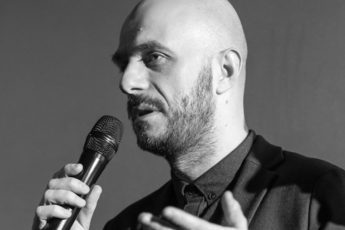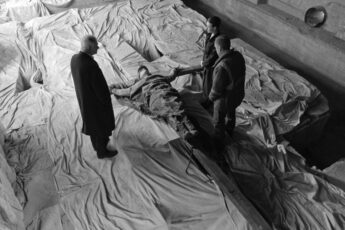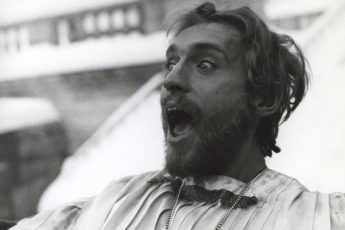
Anastasia Eleftheriou met Miguel Ángel Jiménez during this year’s Thessaloniki International Film Festival to speak to him about his new film, “Seagull”.
Can you tell us something about the production of the film? What was the story behind the co-production betwen Spain, Georgia and Russia?
The production of the film is a co-production between Spain, Georgia and Russia and we started with the Georgians because we had had experience working with them from my first film, “Ori”. The film was shot in Georgia, so it was natural to seek a co-production with them fro my new film. We have two production companies with similar interests, and we are very good friends. After that we found Rustam Ibrahimbekov, a script writer who won an Oscar for Burnt by the Sun, and were supported by the CINETEQUE in Georgia which is always trying to help people from the Caucasus. So we managed to make this co-productio happenn, and we went to the RIMAD (Research Institute for Media, Art and Design). We won their script development prize, and that’s how the co-production really started coming to life…
I understand that it’s surprising for people that these countries made a co-production because of the very recent war and all the conflicts. But you know, we found Rustam Ibrahimbekov who has roots in Baku, Azerbaidjan, and he has always been very focused on the Caucasus and is very good friends with Eldar Shengelaia, a very famous Georgian director, a very old man, who is the director ofthe CINETEQUE. So, apart from the problems and the war, they are very good friends and we had no problem making the co-operation happen.
Where was the film shot?
The film was shot in Georgia and Kazakhstan, although the film is set in Siberia. However, we did not want to shoot in Russia because it would have been very difficult. So when we discovered very similar landscapes in Georgia, we decided to shoot in Georgia and Kazakhstan.
What was the idea behind make a film in such a location?
First of all we wanted to go to Kazakhstan because we did not know anything about it. We saw a photograph by a Norwegian photographer Jonas Bendiksten, from Magnum, and in this photograph we saw some kids playing with a rocket, a rocket which was on the land, and we were very intrigued by that so we really wanted to go to this place. We rented a van and we went all around Kazakhstan, discovering the places we see in the movie, and we also discovered the people and a lot of their stories. So, that was our first motivation behind making the film.
How important was the story-line to you?
Of course it was important, but I always prefer to focus on the shooting, the movement of the camera, the landscape, and on the emotions of the characters… I always prefer photography over story.
Did nature play an important role in your film?
Yes, of course. In the first part, the story on the farm is very important because of the fact that it is isolated and in a very cold place, so the natural environment and the weather are very important for showing the feelings on the farm. It’s as if people there were trapped inside a cage. In Kazakhstan, the landscapes and the dessert were very important means to talk about the main character’s relationship with her father and her will to escape.
How and where did you cast your actors?
First of all, we made a casting in Georgia, in Tbilisi, where we saw 500 people – more or less all the actors they have in Tbilisi – and we chose all the main characters in Georgia. After that we went to Kazakhstan and made another casting there in Almaty, where we chose the boy and the father, but all the main characters are Georgians.
Is the story based on real stories?
It’s based on things we have seen and we have heard of. Of course, we invented many things, but the main characters and the main points are entirely based on real people and real stories.
Did you have any have any problems shooting in Kazakhstan?
Yes, we had many problems shooting there. First of all, there were many problems with the police. Basically, we had problems with everything. In Georgia it was easier, it’s a much better place to shoot. It was very hard because of the weather, and it was terrible to have to walk all day long, but in Kazakhstan the problems with the police and the permissions made it very difficult to work. We did not have such a big budget, and the government was not involved in the project.
The films’ main line – regarding people who are born and die in the same place and people who always search for their home – does it refer to both main characters of your film, the man and the woman? Or does it mostly refer to the woman?
For me, it speaks for both of them. But, of course, mainly about the woman, because she is always looking for a better place, for a better way of live. She is always deciding something new, so she wants to see what there is at the other side of the horizon. But it also represents the man. He settled down, and he found good reasons to stay with the boy. Maybe there would be work for the train-line, so he wanted to stay there.
Do people in those areas have a tendency to move, or do they settle down in families nowadays?
Kazakhstan, as you know, is a land of nomads, they have been nomads for centuries. When they became part of Russia in the 18th century, the first thing that the Russians made was to forbid nomadism. And this brought a big change in the quality of life for those people. There was a lot of hunger, and many of them died. Nowadays, most of them are settled in certain places. They live a modern life.




Leave a Comment